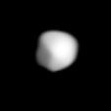Astronomy:230 Athamantis
From HandWiki
Short description: Main-belt asteroid
 | |
| Discovery | |
|---|---|
| Discovered by | K. de Ball |
| Discovery date | 3 September 1882 |
| Designations | |
| (230) Athamantis | |
| Pronunciation | /æθəˈmæntɪs/ |
| Named after | Helle |
| 1949 WG | |
| Minor planet category | Main belt |
| Orbital characteristics[1] | |
| Epoch 31 July 2016 (JD 2457600.5) | |
| Uncertainty parameter 0 | |
| Observation arc | 133.58 yr (48791 d) |
| |{{{apsis}}}|helion}} | 2.52818 astronomical unit|AU (378.210 Gm) |
| |{{{apsis}}}|helion}} | 2.23641 AU (334.562 Gm) |
| 2.38229 AU (356.386 Gm) | |
| Eccentricity | 0.06124 |
| Orbital period | 3.68 yr (1343.0 d) |
| Average Orbital speed | 19.3 km/s |
| Mean anomaly | 116.2° |
| Mean motion | 0° 16m 4.969s / day |
| Inclination | 9.443° |
| Longitude of ascending node | 239.9° |
| 139.1° | |
| Physical characteristics | |
| Dimensions | c/a = 0.76±0.07[2] |
| Mean diameter | 118±2 km[2] 108.99±2.0 km[1] 110.17 ± 4.57 km[3] |
| Mass | (2.3±1.1)×1018 kg[2] (1.89±0.19)×1018 kg[3] |
| Mean density | 2.7±1.3 g/cm3[2] 2.69±0.43 g/cm3[3] |
| Rotation period | 24.0055 h (1.00023 d)[1] 23.99 h[4] |
| Geometric albedo | 0.146 (calculated)[2] 0.1708±0.006 |
| S | |
| Absolute magnitude (H) | 7.35 |
Athamantis (minor planet designation: 230 Athamantis) is a fairly large main-belt asteroid that was discovered by the German-Austrian astronomer K. de Ball on September 3, 1882, in Bothkamp. It was his only asteroid discovery. The asteroid was named after Athamantis, daughter of Athamas the mythical Greek king of Orchomenus.
Photometric observations of this asteroid gave a light curve with a period of 23.99 hours and a brightness variation of more than 0.20 in magnitude.[4] It has the spectrum of an S-type asteroid. During 1991, the asteroid was observed occulting a star. The resulting chords provided a cross-section diameter estimate of 101.8 km.[5]
left|thumb|A three-dimensional model of 230 Athamantis based on its light curve
References
- ↑ 1.0 1.1 1.2 "230 Athamantis". JPL Small-Body Database. NASA/Jet Propulsion Laboratory. https://ssd.jpl.nasa.gov/sbdb.cgi?sstr=230;cad=1.
- ↑ 2.0 2.1 2.2 2.3 2.4 P. Vernazza et al. (2021) VLT/SPHERE imaging survey of the largest main-belt asteroids: Final results and synthesis. Astronomy & Astrophysics 54, A56
- ↑ 3.0 3.1 3.2 Carry, B. (December 2012), "Density of asteroids", Planetary and Space Science 73: pp. 98–118, doi:10.1016/j.pss.2012.03.009, Bibcode: 2012P&SS...73...98C. See Table 1.
- ↑ 4.0 4.1 Zeigler, K. W.; Florence, W. B. (June 1985), "Photoelectric photometry of asteroids 9 Metis, 18 Melpomene, 60 Echo, 116 Sirona, 230 Athamantis, 694 Ekard, and 1984 KD", Icarus 62 (3): pp. 512–517, doi:10.1016/0019-1035(85)90191-5, Bibcode: 1985Icar...62..512Z.
- ↑ Shevchenko, Vasilij G.; Tedesco, Edward F. (September 2006), "Asteroid albedos deduced from stellar occultations", Icarus 184 (1): 211–220, doi:10.1016/j.icarus.2006.04.006, Bibcode: 2006Icar..184..211S.
External links
- The Asteroid Orbital Elements Database
- Minor Planet Discovery Circumstances
- Asteroid Lightcurve Data File
- 230 Athamantis at AstDyS-2, Asteroids—Dynamic Site
- 230 Athamantis at the JPL Small-Body Database
 |

